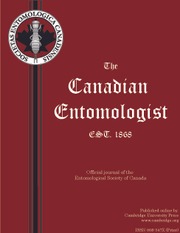Crossref Citations
This article has been cited by the following publications. This list is generated based on data provided by
Crossref.
Hokyo, Nibuhiko
and
Kiritani, Keizi
1963.
Mortality process in relation to aggregation in the southern green stink bug.
Population Ecology,
Vol. 5,
Issue. 1,
p.
23.
Lyons, L. A.
1964.
The Spatial Distribution of Two Pine Sawflies and Methods of Sampling for the Study of Population Dynamics.
The Canadian Entomologist,
Vol. 96,
Issue. 11,
p.
1373.
Henson, W. R.
1965.
Individual Rearing of the Larvae of Neodiprion sertifer (Geoffroy) (Hymenoptera: Diprionidae).
The Canadian Entomologist,
Vol. 97,
Issue. 7,
p.
773.
Tripp, H. A.
1965.
The Development of Neodiprion swainei Middleton (Hymenoptera: Diprionidae) in the Province of Quebec.
The Canadian Entomologist,
Vol. 97,
Issue. 1,
p.
92.
McLeod, J. M.
1966.
The Spatial Distribution of Cocoons ofNeodiprion swaineiMiddleton in a Jack Pine Stand: I. A Cartographic Analysis of Cocoon Distribution, With Special Reference to Predation by Small Mammals.
The Canadian Entomologist,
Vol. 98,
Issue. 4,
p.
430.
Iwao, Syun'iti
1970.
Analysis of contagiousness in the action of mortality factors on the western tent caterpillar population by using the relationshiprelationship.
Population Ecology,
Vol. 12,
Issue. 1,
p.
100.
Pschorn-Walcher, H.
and
Eichhorn, O.
1971.
Untersuchungen über die Eiparasiten (Hym.: Chalcidoidea) der rotgelben Kiefern-BuschhornblattwespeNeodiprion sertifer Geoff. (Hym.: Diprionidae).
Anzeiger für Schädlingskunde und Pflanzenschutz,
Vol. 44,
Issue. 7,
p.
97.
Knerer, G.
and
Atwood, C. E.
1973.
Diprionid Sawflies: Polymorphism and Speciation.
Science,
Vol. 179,
Issue. 4078,
p.
1090.
Pschorn‐Walcher, H.
and
Eichhorn, O.
1973.
Studies on the biology and ecology of the egg parasites (Hym.: Chalcidoidea) of the pine sawfly Neodiprion sertifer (Geoff.) (Hym.: Diprionidae) in Central Europe.
Zeitschrift für Angewandte Entomologie,
Vol. 74,
Issue. 1-4,
p.
286.
Mallach, N.
1974.
Zur Kenntnis der Kleinen Kiefern‐Buschhornblattwespe,Diprion (Microdiprion) pallipes(Fall.) (Hym., Diprionidae).
Zeitschrift für Angewandte Entomologie,
Vol. 75,
Issue. 1-4,
p.
337.
Beaver, R. A.
and
Laosunthorn, Danee
1975.
The biology and control of the pine sawfly, Nesodiprion biremis (Konow) (Hymenoptera, Diprionidae), in northern Thailand.
Bulletin of Entomological Research,
Vol. 65,
Issue. 1,
p.
117.
All, J. N.
and
Benjamin, D. M.
1976.
POTENTIAL OF ANTIFEEDANTS TO CONTROL LARVAL FEEDING OF SELECTED NEODIPRION SAWFLIES (HYMENOPTERA: DIPRIONIDAE).
The Canadian Entomologist,
Vol. 108,
Issue. 11,
p.
1137.
Stamp, Nancy E.
1981.
Effect of group size on parasitism in a natural population of the Baltimore checkerspot Euphydryas phaeton.
Oecologia,
Vol. 49,
Issue. 2,
p.
201.
EICKWORT, GEORGE C.
1981.
Social Insects.
p.
199.
ADACHI, Ishizue
1981.
Comparison of the Effects of Larval Aggregation between Gregarious and Solitary Species of Sawflies : Arge nigrinodosa MOTSCHULSKY and Arge nipponensis ROHWER : Hymenoptera : Argidae.
Applied Entomology and Zoology,
Vol. 16,
Issue. 4,
p.
477.
Sheehan, Katharine A.
and
Dahlsten, Donald L.
1985.
Bionomics ofNeodiprionspecies on white fir in northeastern California.
Hilgardia,
Vol. 53,
Issue. 8,
p.
1.
Ohmart, C. P.
Thomas, J. R.
and
Stewart, L. G.
1987.
NITROGEN, LEAF TOUGHNESS AND THE POPULATION DYNAMICS OF PAROPSIS ATOMARIA OLIVIER (COLEOPTERA: CHRYSOMELIDAE)—A HYPOTHESIS.
Australian Journal of Entomology,
Vol. 26,
Issue. 3,
p.
203.
Chang, Kwang‐Shing
and
Morimoto, Naotake
1988.
Life table studies of the walnut leaf beetle, Gastrolina depressa (Coleoptera: Chrysomelidae), with special attention to aggregation.
Population Ecology,
Vol. 30,
Issue. 2,
p.
297.
Wagner, M. R.
and
Frantz, D. P.
1990.
Influence of induced water stress in ponderosa pine on pine sawflies.
Oecologia,
Vol. 83,
Issue. 4,
p.
452.
McCAULEY, DAVID E.
1992.
Family structured patterns of mortality in the false Colorado potato beetle.
Ecological Entomology,
Vol. 17,
Issue. 2,
p.
142.

